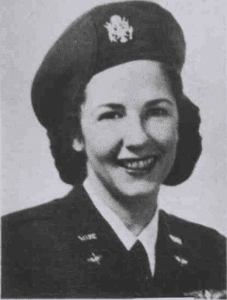 Mary Eleanor Martin Sabota
Mary Eleanor Martin Sabota

Mary Eleanor Beckley – Ambition: To be an aviatrix
Class 44-W-3
February 5, 1918 – November 23, 1999
Planes flown: PT-17, BT-13, AT-6, AT-10, B-25, B-26, P-40 ,P-63
Training Location: Avenger Field (Sweetwater, Tex.)
Assigned bases: Dodge City Army Air Base (Kan.), Blytheville Army Air Field (Ark.), and Laredo Army Air Base (Tex.)
High School Ambition: To Be an Aviatrix
Mary Eleanor Beckley, known as Eleanor to her family, was born on February 5, 1918, to Dr. and Mrs. Daniel W. Beckley in Bloomsburg, Pennsylvania, a town about 140 miles northwest of Philadelphia. Her nickname was Tommy. She often told her friends, “Just call me Tommy.”
Eleanor’s dad, Dr. Daniel Beckley, a physician and surgeon, was an avid aviation enthusiast and pilot. In 1932 he directed the first air ambulance flight in the US. His passion for aviation was passed on to his family. Eleanor, her brother Robert, and her cousin George all became pilots. By 1941 they became known as the “Flying Beckleys.”
Eleanor graduated from First Catholic Slovak High School, also known as St. Cyril’s Academy, a girls boarding school in Danville, Pennsylvania. On her page of the class yearbook, she stated that her ambition was “To be an aviatrix.”
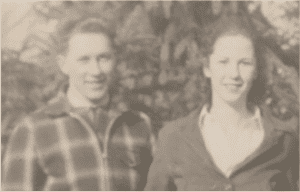
John Joseph Martin and Mary Eleanor Beckley
Eleanor’s first true love was Johnny Martin from Berwick, Pennsylvania. They met when Eleanor was 12 years old and they started dating seriously when she was 21. Eleanor said, “I met him when I was 12 years old and I wanted him for my best friend, my lover, and my very own.”
In 1940, Eleanor graduated from Bloomsburg State Teachers College and completed post graduation courses for a specialty in teaching mentally handicapped children. While Eleanor had a great interest in teaching, her love for flying blossomed while in college through the Civilian Pilot Training (CPT) program at the Bloomsburg Municipal Airport.
This federally sponsored program was designed to promote aviation and to train up a cadre of pilots who could be quickly trained in military flying should the need arise. They allowed one woman per class or one female for every ten male students. “This is where it all started,” Eleanor said in her scrapbook.
Dr. Beckley demonstrated his passion for supporting the war effort by joining the British war effort as a surgeon at Calderstones Emergency Hospital in Lancashire, England in January 1941. This passion was also passed on to his family and friends.

Mary Eleanor Beckley CPT Class 1940
Two months later in March 1941, Johnny Martin joined the Army Air Corps, soon to be renamed the Army Air Forces. He joined as a private and was soon appointed as an aviation cadet. In September 1942, Johnny graduated and was commissioned as 2nd Lieutenant at Ellington Field, Texas. Johnny became a B-17 pilot and was assigned to the 533rd Bomb Squadron, 381st Bomb Group in the Eighth Air Force.
In January 1943, Eleanor learned about an opportunity to become a Trainee Traffic Controller based on her college degree and CPT training. Eleanor also learned that she was of interest to the quickly developing Women’s Flying Training Detachment. She was invited to apply for admission to the program in a March 1943 letter from Jacquelin Cochran, director of the Women’s Flying Training Detachment. Eleanor began the application process immediately.
Just before Johnny shipped out to England, Johnny and Eleanor were married on May 14, 1943. They spent two days together as a married couple before Mary Eleanor Beckley Martin returned to Pennsylvania. She rendezvoused with Johnny one more time, in Maine, just before he left the US as his bomb group made their last stop in their flight to England.
After they completed their final training in England, Johnny’s squadron flew their first bombing mission on June 22, 1943, in a diversionary raid aimed at the General Motors plant in Antwerp, Belgium. Johnny’s ship, Boeing B-17F 42-30021 was shot down and crashed in Holland.
The navigator, Wallace Hoag, and bombardier, Harry Long, managed to parachute safely and spent the remainder of the war in a German POW camp. Johnny and the other seven crew members died in the crash.
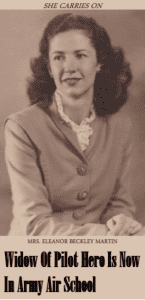
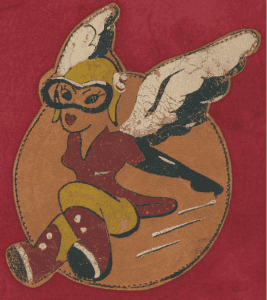 Eleanor became a widow after only 39 days of marriage at age 25. Although deeply grieving the loss of her first love, she “pluckily decided to carry on.” The tragedy made Eleanor only more determined to do her utmost in the war effort.
Eleanor became a widow after only 39 days of marriage at age 25. Although deeply grieving the loss of her first love, she “pluckily decided to carry on.” The tragedy made Eleanor only more determined to do her utmost in the war effort.
The Women’s Flying Training Detachment was re-designated Women Airforces Service Pilots (WASP) in August 1943 after moving from Houston Municipal Airport to Avenger Field in Sweetwater, Texas in February 1943.
In September 1943, Mary Eleanor Beckley Martin was accepted into the WASP program and received “orders” to report to the WASP training center in Sweetwater, Texas as a trainee, effective October 4, 1943. Eleanor was known as Mary Martin in the WASP program.
By the time Eleanor reported for training, the WASP program was well under way because of tremendous efforts by female aviation pioneers Nancy Harkness Love and Jacqueline Cochran with the help of the commanding general of the US Army Air Forces, General Henry H. (Hap) Arnold.
Eleanor and the other WASP trainees had a mascot called Fifinella who was a female gremlin designed by Walt Disney for a proposed movie that never happened. The WASP asked permission to use the image as their official mascot, and the Disney Company granted them the rights.
Eleanor had expectations of receiving a commission in the Army Air Forces upon graduation. From its inception, the WASP program was intended to become fully militarized and was designed to be almost identical to the male cadet training program. Eleanor was introduced to military life as soon as she arrived in Sweetwater.
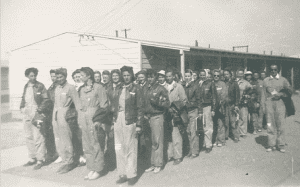
Mary Eleanor Martin (Sabota) front row, third from left 44-W-3 Formation, October 5, 1943
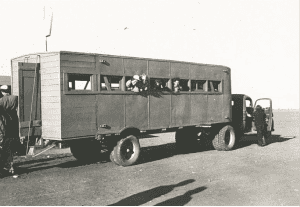
WASP trainees were picked up in Sweetwater by a “Cattle Truck” and delivered to Avenger Field
Life at Avenger

“Never have been able to balance this. There just isn’t enough to go round.”
Eleanor was now a member of the 318th Army Air Forces Flying Training Detachment (AAFFTD), Class 44-W-3, effective October 4, 1943. She was in WASP training at Avenger Field from October 5, 1943, until April 15, 1944.
You’re in the Army now!
Well, … not really in the Army. Eleanor and her fellow trainees and graduate pilots were civilian employees with the plan for them to be militarized or to become commissioned Army officers. One of Eleanor’s monthly check stubs illustrates that trainees had room and board deducted from their pay, as well as other items such as gym suits.
Because WASP trainees were civilians, there were differences between them and male Army Air Forces Cadets. Some of the key differences were:
• WASP could resign at any time
• WASP had to pay Room and Board
• WASP had to pay transportation
• WASP had NO military honors or death benefits
Just like Army Cadets, Eleanor lived in barracks that were called bays. Eleanor was assigned to bay F8. Her bay mates included Vera McMillan of Canada, Lea Ola McDonald of Texas, Theda Rae McKnight of Texas, Pauline Mason of Florida, and Isabelle McCrae of Colorado.
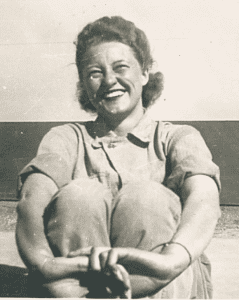
Vera McMillan
Canada
Washed Out
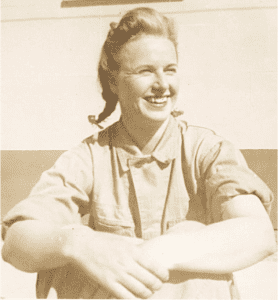
Lea Ola McDonald
Texas
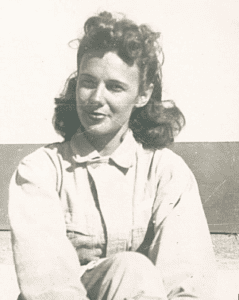
Isabelle McCrae
Colorado

Theda Rae McKnight
Texas
Washed Out
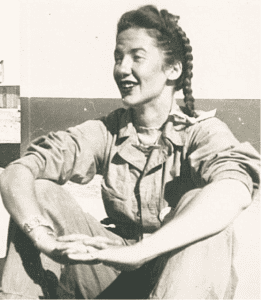
Mary Eleanor Martin (Sabota)
Pennsylvania

Pauline Mason
Florida
Washed Out
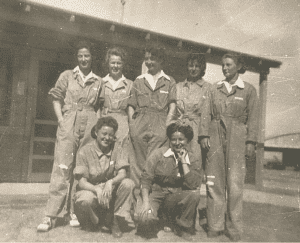
Bay F8 Trainees
Mary Eleanor Martin (Sabota) is back row far left
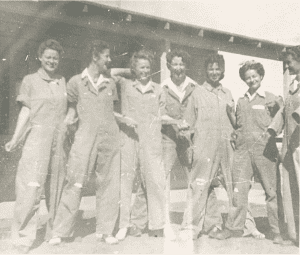
Zoot Suits! Mary Eleanor Martin (Sabota) is second from the left
Eleanor and her bay mates were issued two sets of men’s Army olive drab herring bone twill coveralls, which were known as Zoot Suits. Army uniforms are said to only come in two sizes: too big and too small.
Winter PT uniforms consisted of sweat pants and sweat shirts. Leather A-2 jackets, which they wore with their “dress” training uniform, were issued to them. Leather winter flying suits were also issued for use in open cockpit training aircraft.
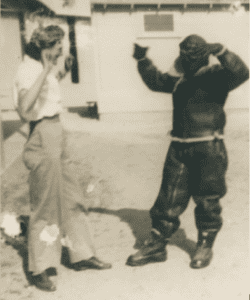
Winter flying suit
“Worn by HP in Primary Trainers”
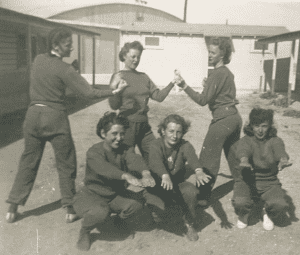
PT- “Boy are we sharp”
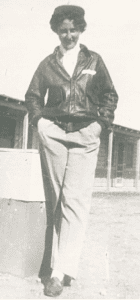
Dress
One thing these women were not issued was shoes. They wore the shoes they brought from home. The women trainees also had to do something with their hair in the cockpit. French braiding was popular; then Urban’s turbans became required. The name of this hair wrap came from Major Robert Urban, commander of the 318th Army Air Forces Flying Training Detachment. The WASP program was under his command.

The days of turbans.Mary Paul McCloo
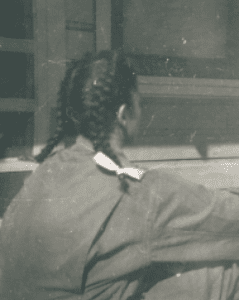
B. T. before days of turbans
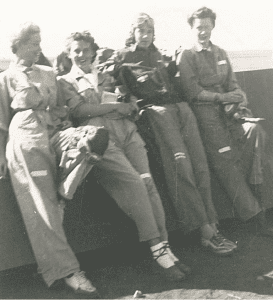
Are those Army shoes?
For the 1943 Christmas holiday, Eleanor and her fellow trainees could invite family to visit, and male Cadets were “imported” for holiday parties. Eleanor’s mother and father traveled to Sweetwater for the Christmas holiday. Normally male presence, other than instructors and ground crews, on Avenger Field was strictly forbidden. Sanctioned events such as holiday parties were the exceptions.
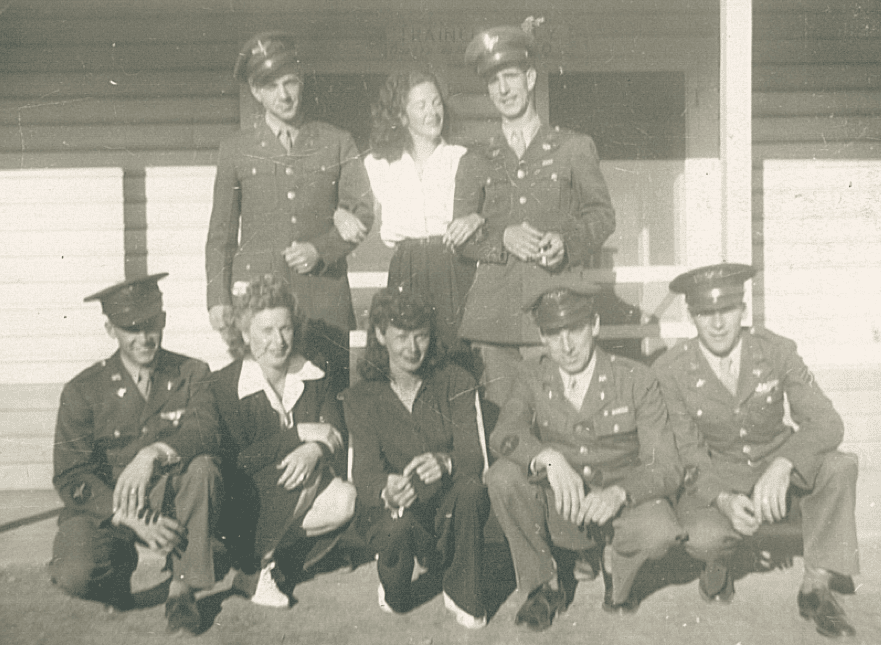
“Male Cadets brought in for a Christmas holiday dance. Mother and Dad came down for the holidays.”
Mary Eleanor Martin (Sabota) is back row, center.
Training
Eleanor’s WASP training curriculum was the same as that of male cadets and consisted of military training, ground school, and flight training from primary through advanced.
Based on her transcript, Eleanor’s ground school training consisted of the following:
- Preflight Mathematics 20 hours
- Preflight Physics 24 hours
- Preflight Map & Charts, Etc. 18 hours
- Primary Navigation 18 hours
- Primary Aircraft 18 hours
- Primary Engine 40 hours
- Primary Weather 12 hours
- Basic Navigation 24 hours
- Basic Weather 24 hours
- Advanced Navigation 12 hours
- Instruments 22 hours
- Radio Code 30 hours
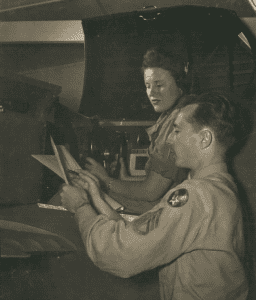
“This I was good at.”
By the time Eleanor’s class of 44-W-3 began, the requirements had been adjusted for training efficiency and improved quality. Duration and hours increased, and three flight training phases had changed to two. Sweetwater was the only AAF (Army Air Forces) school where all phases of training through graduation were conducted at one base. Army cadets, on the other hand, moved from one base to another as they progressed through their training.
Eleanor was good at training in flight simulators, called Link Trainers. She would sit in the cockpit of the “plane” with the hood down and “fly” the pre-arranged flight plan or as directed by the training technician. The “plane” would move in response to the pilot moving the controls, and the training technician would record their results.
Primary Phase Flight Training
n the primary phase, the first plane Eleanor flew was the Fairchild PT-19. While nothing like the fighters in service at the time, it was bigger and more powerful than small civilian planes like the Piper Cub, which had a 40 to 50 horsepower engine. The PT-19 was a simple but rugged airplane with fixed landing gear and an open cockpit.
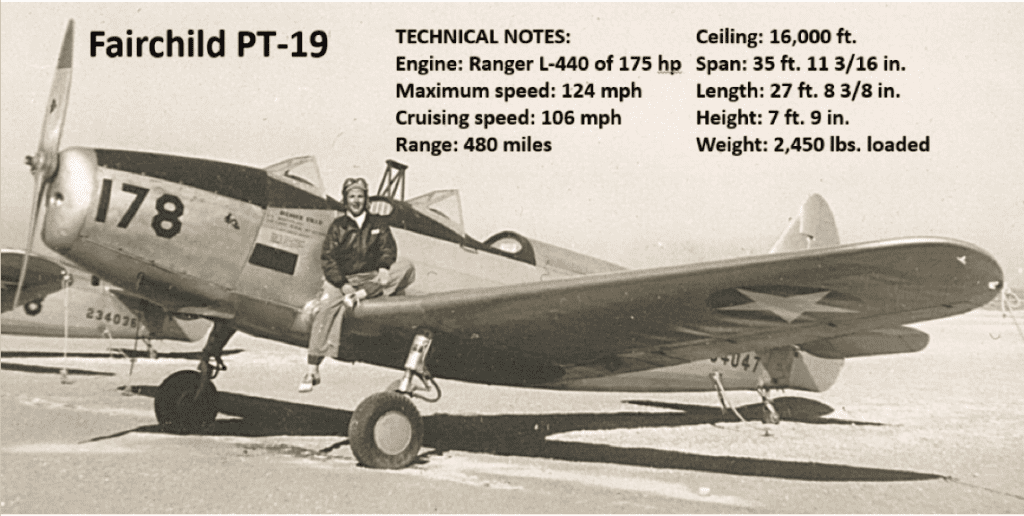
Mary Eleanor Martin (Sabota) “This is the future soul mate.”

Mary Eleanor Martin (Sabota)
“Now the work begins – try to keep time straight – you know my addition, just like my spelling.”
The The solo flight for a trainee was the first milestone in the program and very important. After their solo flight, the trainee was acknowledged as a “hot” pilot (HP). They were also entitled to wear their solo scarf. Eleanor’s mother made her silk solo scarf, which she wore for the first time during her solo flight. Her father traveled all the way from Pennsylvania to witness the event.
The trainee’s solo flight was a big event! Ring the bell and get tossed into the wishing well. Welcome to the Solo Club!
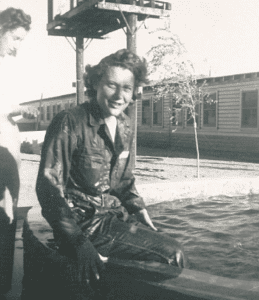
“This is what happens when you solo.”
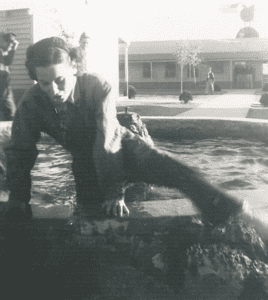
“Yes, they take your shoes off.”
Advanced Phase Flight Training
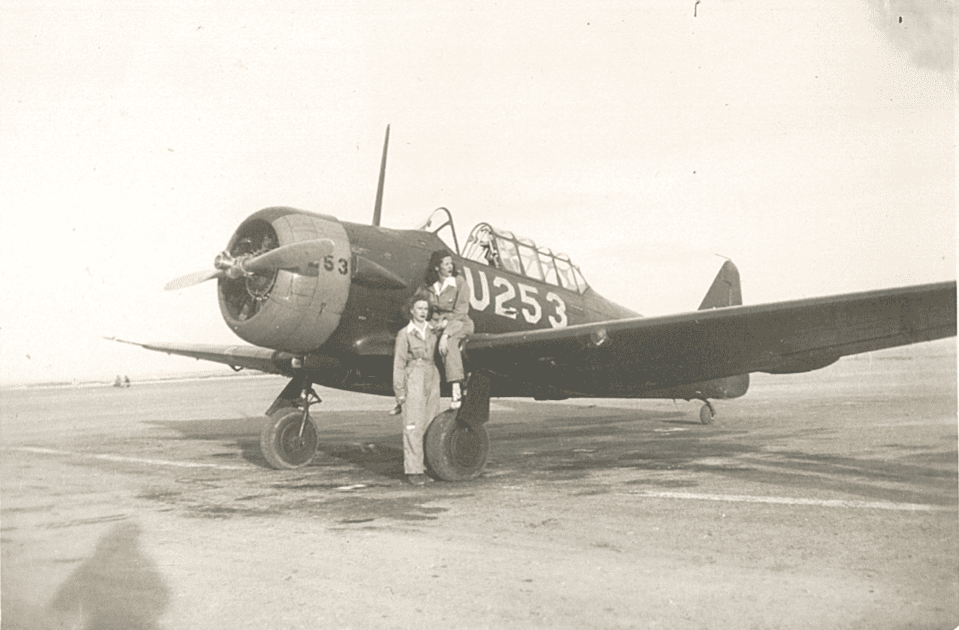
Lea Ola McDonald (standing) and Mary Eleanor Martin (Sabota)
“Mac and Tommy meditating on the lovely AT-6’s virtues”
In the advanced phase, Eleanor first flew the North American AT-6. At the time, this was the largest and most powerful single engine trainer in the US military. Trainees who could not handle the more powerful ship on takeoffs and landings washed out.
The AT-6 was also the first aircraft used in training which had a radio. Learning radio procedures was a new skill to practice, on top of learning to fly the more advanced airplane.
After their orientation in the AT-6, Eleanor also flew the Vultee BT-13. This plane had power comparable to the AT-6 but did not have retractable landing gear or a hydraulic system. The landing flaps were controlled by a mechanical cable system. This aircraft was primarily used for instrument flight training. Takeoff, flying, and landing were done with the hood down. All the pilot could see were the instruments. Eleanor received her Army instrument flying certificate by flying the BT-13 with the hood down. The credentials Eleanor received in WASP training were the same as those received by male Army cadets.
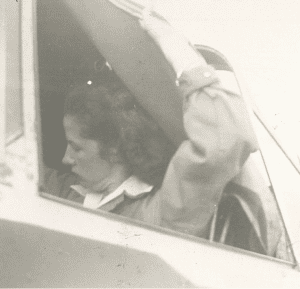
Tommy Martin in the cockpit of the BT-13 “It’s simple, all you do is pull the hood up and over – then the work really begins!”
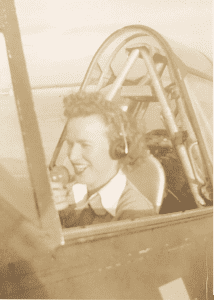
Lea Ola McDonald. “Mac thinks talking to it soft and sweetly will do the trick”
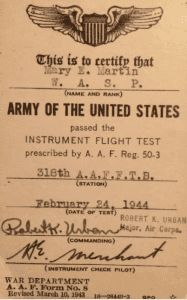
Certificate – Instrument Flight test
Instructors
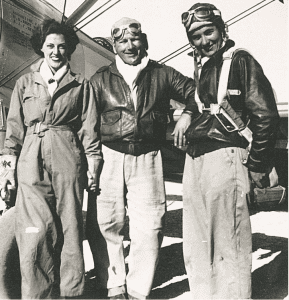
Grant “Pappy” Pool (center)
Flight Commander of Primary Class
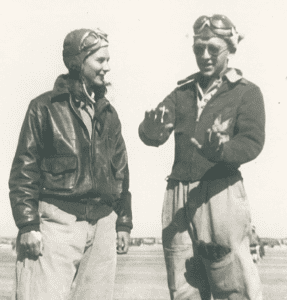
Simms (right)
2nd Instructor
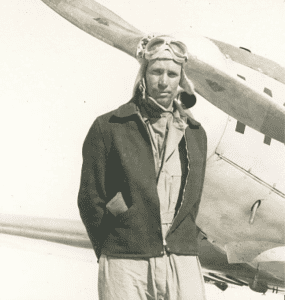
Mr. Fachs
“He was brave enough to solo me or perhaps he was tired of risking his neck.”

Ted Merchant; “Instrument Instructor and inspector for everyone. You had to pass his check ride for instrument card.”
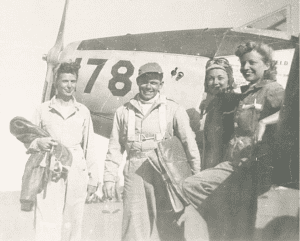
“Tut Tut Girls – No social relationship with instructors – Those grins are far too friendly”
All the instructors were civilian pilots certified by the Army and employed by Aviation Enterprises Inc.
As you can imagine, there were very strict rules about interaction between the male instructors and the female trainees.
Ted Merchant was the chief pilot over all the civilian instructors. Eleanor and all trainees had to pass his check ride to get their instrument card. Additionally, everyone had to pass check rides from Army pilots as part of their certification.
Best Friends
The ground crew were also civilians. They had the very important job of keeping Eleanor and all the WASP trainees flying safely.
As in most military settings, shared hardships produce great friends. The WASP trainees were no different. This was especially true for Lea Ola McDonald and Mary Eleanor Martin. They became very close friends.
Publicity
Publicity was especially important to the WASP program. They worked to put forth a positive image during the campaign to have Congress vote in favor of allowing them to fully join the Army Air Forces. Eleanor appeared in quite a few WASP publicity photos taken by Army photographer Joe Whitley.

Instructor and Mary Eleanor Martin (Sabota)
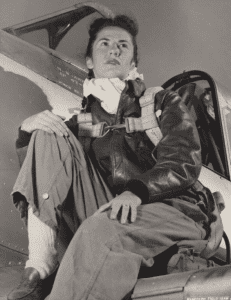
Mary Eleanor Martin (Sabota)
Wash Outs
Three of Eleanor’s bay mates washed out. Trainees were eliminated, or washed out, from the training program for flying deficiency, resigning, or receiving a medical discharge. WASP graduation rate was similar to that
of Army male cadets.
Graduation
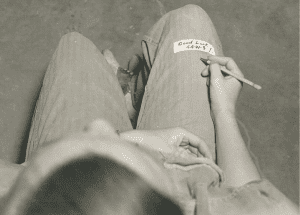
“This is how we kept our flying time. It’s a patch of adhesive tape – everyone had to do it and it had to be the same time the control tower had for our log books”
Each class worked to prepare for the graduation celebration of the class behind them. Eleanor’s class worked to prepare for the celebration of 44-W-2.
Many photos of WASP, such as the one included here, taken during Eleanor’s graduation, show adhesive tape on the pant leg above the knee. They used this tape to write down flying times while flying which could later be transferred to their log books. Each page of the flight log book had to be checked for accuracy against tower logs and approved.
Eleanor’s class, 44-W-3, graduated Saturday, April 15, 1944. Beginning with the class of 44-W-1, graduates wore the WASP Santiago blue dress uniform. WASP were the only women in WWII to wear a beret and the blue color. Favored by General Arnold, Santiago blue became the color of the US Air Force uniform when the US Army Air Forces separated from the Army in 1947.
Killed in Service
Over the course of the WASP program 38 women were killed while flying for their country. One WASP killed in action was Lea Ola McDonald, Eleanor’s best friend. On June 21, 1944, one year to the day from Johnny’s death, she was killed in a Hell Diver crash. Another tragedy for Eleanor. Family letters indicate that this event had a lasting impact on Eleanor. Also, because the WASP were civilians, there was no provision for the Army to pay to care for the bodies or ship them home for burial. A collection was taken up to pay these expenses.
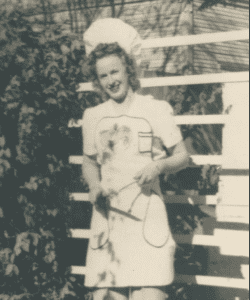
Lea Ola McDonald my bay mate and best friend. Killed in a Hell Diver (crash) 21 June 1944, El Paso, Texas. One year from Johnny’s death, to the day.”
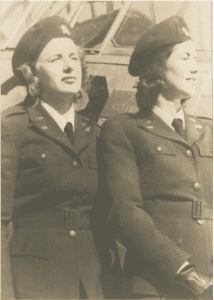
Lea Ola McDonald and
Mary Eleanor Martin (Sabota) during 44-W-3 graduation
Transitional Training
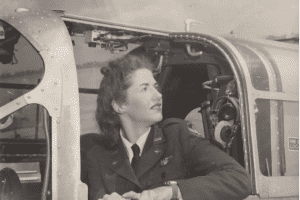
Mary Eleanor Martin (Sabota) Publicity photo, Twin engine training Beechcraft AT-10, Training to fly B-26
In May 1944, Eleanor began transitional training at Blytheville Army Airfield, Arkansas, to prepare to fly the B-26 bomber. While at Blytheville in the summer of 1944, she flew the Beechcraft AT-10 twin engine trainer, the Curtis Wright AT-9, as well as the twin engine Cessna UC-78.
WASP Militarization
According to the plan to militarize the WASP program, select graduates, including Eleanor, were sent to officer’s training classes at the Army Air Forces School of Applied Tactics. This school was designed to prepare WASP graduates to accept commissions in the Army Air Forces. However, by the time that Eleanor started the class, the WASP militarization bill had been voted down in Congress.
Militarization of the WASP was very much expected to happen as evidenced by Eleanor’s home town newspaper reporting “First Area Girl Commissioned In Air Corps.” Additionally, the grave marker of Lea Ola McDonald reads LT US AAF.
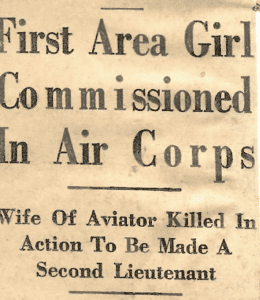
Eleanor’s home town newspaper
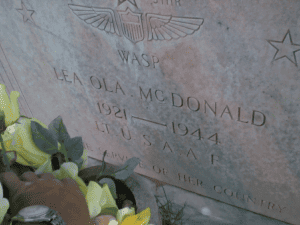
Lea Ola McDonald grave marker
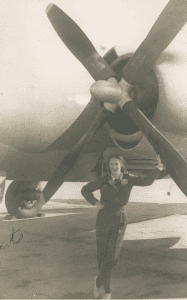
“These are big boys as you can see. I’m 5’9”
Operational Duty
In September 1944, after officer’s training, Eleanor was transferred to Laredo Army Air Field in Laredo, Texas, where she began her operational duty, flying the Martin TB-26 Marauder, twin engine medium bomber. This aircraft was not easy to fly, thus nicknamed the “Widowmaker.”
In Eleanor’s words, WASP operational flying at Laredo, Texas, included the following assignments:
• Test Pilot for B-26. Test hop planes following maintenance on aircraft.
• Towed targets for 50 caliber flexible gunnery school, air to air. 4 hours every mission, 2 missions a day, seven days a week.
• Towed targets for research of the B-26 electrical guns at altitude. No one wanted to do this.
• Checked out pilots returning from overseas combat assignments as to the procedure required for towing targets.
• Towed targets for research in use of plastic bullets.
Eleanor and the other Laredo WASP staff pilots pulled targets for aerial gunnery practice for crews of the B-17 bomber and P-39 fighter pilots. Just imagine what it must have been like to have rookie gunners learning the ropes by shooting at a target on a 20-yard cable behind the tail of the B-26.
The biggest of the day, the Boeing B-29 Superfortress also fired on targets pulled by the WASP pilots. The B-29 had a pressurized cabin with electrically controlled guns, aimed by gunners looking through closed windows.
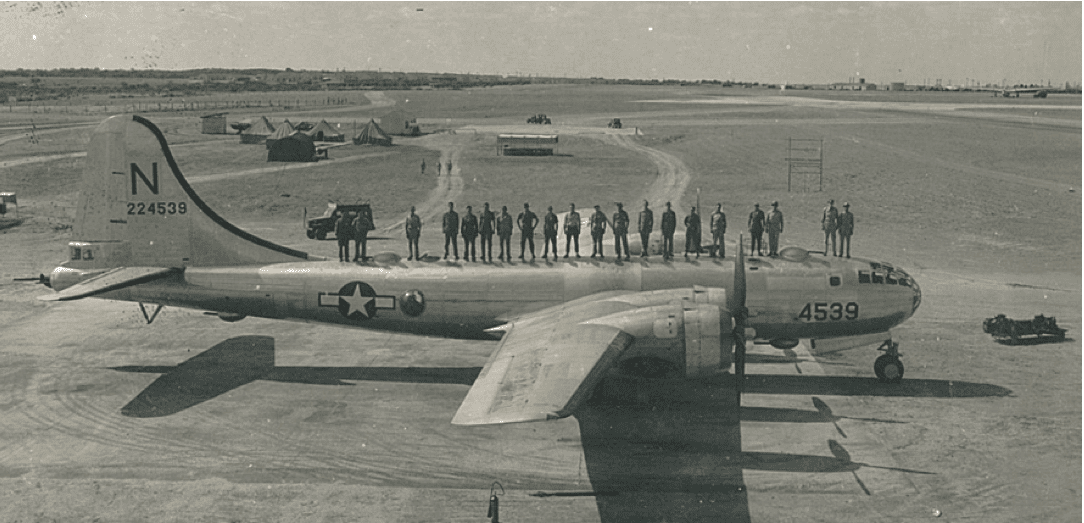
“I towed targets for this one for research on electrical guns. It was hard work.”

December 1944 photo of WASP staff Larado Army Air Field. (Left to right) Back row: Dorathea Rexroad (Parmenter) (Scatena) 44-W-6, Mary Eleanor Martin (Sabota) 44-W-3, Myrtle Allen (Carter) 44-W-4, Dorothea Baumeister (Hamilton) 44-W-5 Front row: Lillian Calkins (Eno) 44-W-5, Susie Winston (Bain) 44-W-4, Dottie Swain (Lewis) 44-W-5, Unidentified.
Failure to Militarize
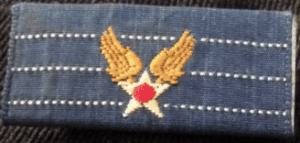
Army Air Forces 6 months Emblem of Civilian Service Ribbon from Eleanor’s collection.
During the second half of 1944 a series of political events occurred which concluded with the deactivation of the WASP program on December 20, 1944. The war was not over and there was still a need for the role filled by the WASP. However, the authorities seemed to conclude that there were now enough male pilots to satisfy that need.
On the day of WASP deactivation, Eleanor received the Army Air Forces Emblem of Civilian Service at Laredo Texas. She was now going to have to seek a new career path.
WASP Were Different
Eleanor was a part of a unique women’s wartime service organization. WAC (Army), WAVES (Navy), SPARS (Coast Guard), MCWR (Marine Corps Women’s Reserve), were all militarized and all had enlisted and officers. WASP were ALL pilots!
In her book Clipped Wings, Molly Merryman makes an interesting observation:
“The WASP were the first American wartime service unit comprised entirely of women who performed functions traditionally associated with men . . . the WASP program remained unique because all of the women who served were pilots; thus, they all served in positions desired and admired by men.”
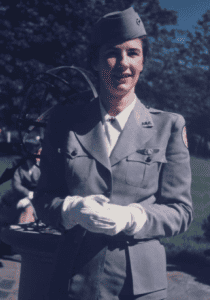
Mary Eleanor Martin (Sabota) in her Red Cross uniform, featuring her WASP wings
Post WASP Career
Eleanor and other disbanded WASP were encouraged to seek employment in the aviation sector. Many did, but the opportunities were limited.
Apparently, there were rumors that WASP would be able to enter the Women’s Army Corps as rated flying officers. On February 22, 1945, Jacquelin Cochran issued a letter to all former WASP stating, “No hope can be held out to former WASP of a return to military flying duties through the WAC or through any other civilian or militarized arrangement now visible.”
Not wanting to sit out the rest of the war, Eleanor joined the American Red Cross. She served in Manila, Philippines and in Germany as program director, supporting US occupation troops. It is interesting to note that she continued to wear her WASP wings on her Red Cross uniform.
While stationed in Germany, Eleanor suffered a neck fracture with significant complications in 1946. This ended any future flying possibilities and caused a 10-year break in her working career.
Civilian Air Force Career
After recovery from her injury, she continued to serve the US Army and US Air Force as hospitality coordinator and director at Ft. Rucker, Ft. Benning, and finally Moody Air Force Base. During her time at Ft. Rucker, Eleanor was married to Eugene Sabota, an Army officer and decorated WWII veteran.
In 1979, Eleanor retired after completing a 26-year civilian Air Force career. In a fitting tribute to her service to the Air Force and as a WASP, Eleanor was asked to taxi an F-4 Phantom

Eleanor Sabota taxis in an F-4 on the base flightline, a friendly gesture from Moody to a former WASP, upon her retirement.” (U.S. Air Force Photo by SSgt. Mitch Crowley)
fighter jet down the flight line at Moody Air Force Base. This was an extraordinary gesture! How many civilians are placed in the pilot’s seat, in control of a military jet fighter?
Mary Eleanor Beckley Martin Sabota (call me Tommy) passed away in 1999 at the age of 81. She endured many tragedies in her life, including the sudden loss of her first husband, the tragic death of her best friend, as well as serious injury and illness. She preserved through all the tragedies that life threw at her. She served her country well throughout the war and beyond, leading a meaningful life.
Source:
Thank you to Jennings Rowell: Mary Eleanor Beckley Martin Sabota “Call Me Tommy Collection” for submitting this. All rights reserved
Visit the WASP Virtual Museum to see Mary’s Flight log book and Flight records!
Additional resources:
Findagrave.com
Texas Women’s University





